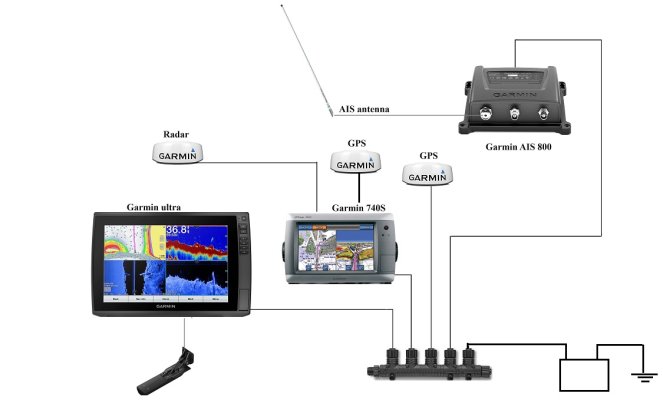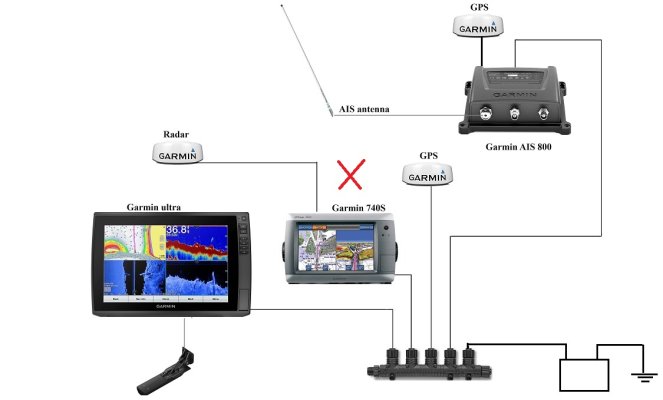You are using an out of date browser. It may not display this or other websites correctly.
You should upgrade or use an alternative browser.
You should upgrade or use an alternative browser.
AIS Integration
- Thread starter man7sell
- Start date
The friendliest place on the web for anyone who enjoys boating.
If you have answers, please help by responding to the unanswered posts.
If you have answers, please help by responding to the unanswered posts.
AnsleyS
Senior Member
I see that you have two GPS antennas planned. My suggestion is that you hook one of these to the AIS system so that it will have its own antenna. The AIS system will not feed GPS info into the NMEA2000 system so you will need to have one to feed the plotters etc and that leaves one for the dedicated AIS.
man7sell
Senior Member
I see that you have two GPS antennas planned. My suggestion is that you hook one of these to the AIS system so that it will have its own antenna. The AIS system will not feed GPS info into the NMEA2000 system so you will need to have one to feed the plotters etc and that leaves one for the dedicated AIS.
That's a good suggestion. The GPS antenna is an existing one that feeds the plotter. So by redirecting to the AIS as a dedicated antenna would work better for the system.
Revised drawing:
Attachments
man7sell
Senior Member
Why the extra GPS antenna on the NMEA 2K bus? Also, don't the 740S and AIS 800 have built-in GPS antennas? I'm not sure about the Ultra.
Yes they have built in GPS antennas, however, I wanted a NMEA 2000 GPS antenna to feed the system already purchased. The other GPS antenna is already existing as the internal ones take a lot longer to come online.
ranger58sb
Guru
- Joined
- Aug 21, 2013
- Messages
- 7,266
- Location
- Annapolis
- Vessel Name
- Ranger
- Vessel Make
- 58' Sedan Bridge
Our AIS transceiver has its own dedicated GPS mushroom antenna. (I think the "dedicated" part is a rule, but not sure.)
Then in each MFD, I selected the AIS unit as the N2K network GPS source.
Additional GPS sources, at least one pre-existing mushroom and also including those built into each MFD, became superfluous. Comparisons with pre-existing built-in MFD GPS antennas vs. the AIS mushroom on the hardtop, no contest, the mushroom is way more accurate. Maybe a combination of open hardtop mounting versus covered built-ins and maybe efficacy of each design...
-Chris
Then in each MFD, I selected the AIS unit as the N2K network GPS source.
Additional GPS sources, at least one pre-existing mushroom and also including those built into each MFD, became superfluous. Comparisons with pre-existing built-in MFD GPS antennas vs. the AIS mushroom on the hardtop, no contest, the mushroom is way more accurate. Maybe a combination of open hardtop mounting versus covered built-ins and maybe efficacy of each design...
-Chris
Bob Cofer
Guru
The network GPS antenna will supply information to all of the connected devices and it is very fast. I would suggest not connecting the existing one but leave it installed as a backup. I have almost the identical setup on Puffin.
man7sell
Senior Member
The network GPS antenna will supply information to all of the connected devices and it is very fast. I would suggest not connecting the existing one but leave it installed as a backup. I have almost the identical setup on Puffin.
Now that's interesting, so all I would have to do is have it feed the backbone and it would talk to all units connected including the AIS
twistedtree
Guru
There are two types of "GPS antennas" available for your system.
One type is a NMEA 2000 device that connects directly to the N2K bus, and makes data available to anyone on the bus who cares to listen. For Garmin this would be a GPS-24xd, or an MSC-10
The other type is really just an external antenna to enhance reception for an internal GPS in your chart plotter, AIS, or VHF. This connects directly to the device using a BNC cable and allows for better reception for the internal GPS. For Garmin, this is a GA 38.
If you want better GPS reception for your AIS, you need to connect a GA-38 directly to the AIS. Class B AIS has to use the internal GPS. It can't use one that's on the NMEA 2000 network. Note that with Class A AIS, it needs BOTH an internal GPS and a connection to the ship's main GPS.
One type is a NMEA 2000 device that connects directly to the N2K bus, and makes data available to anyone on the bus who cares to listen. For Garmin this would be a GPS-24xd, or an MSC-10
The other type is really just an external antenna to enhance reception for an internal GPS in your chart plotter, AIS, or VHF. This connects directly to the device using a BNC cable and allows for better reception for the internal GPS. For Garmin, this is a GA 38.
If you want better GPS reception for your AIS, you need to connect a GA-38 directly to the AIS. Class B AIS has to use the internal GPS. It can't use one that's on the NMEA 2000 network. Note that with Class A AIS, it needs BOTH an internal GPS and a connection to the ship's main GPS.
Similar threads
- Replies
- 13
- Views
- 1K
- Replies
- 19
- Views
- 3K
- Replies
- 3
- Views
- 334


